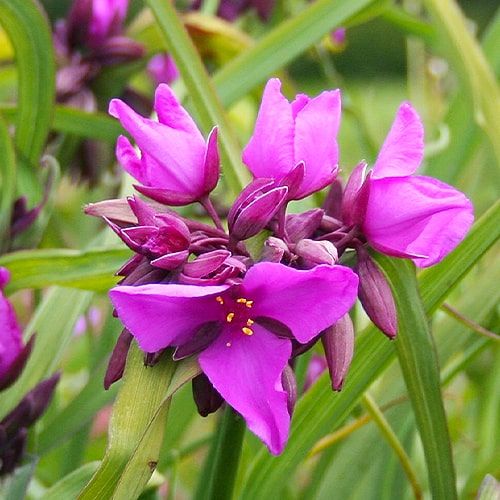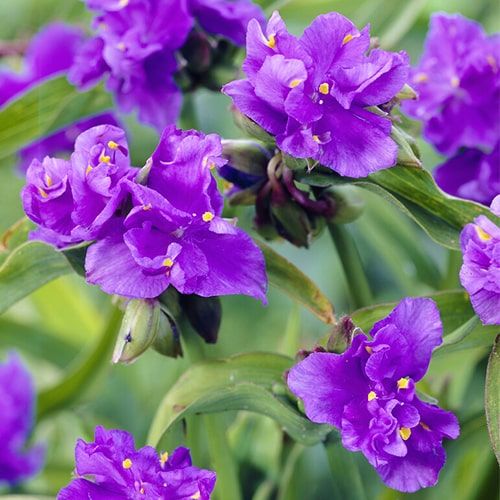Tradescantia (Spiderwort)
Tradescantia (Spiderwort)
Last Reviews
Discover the Elegance of Tradescantia (Spiderwort)
Tradescantia, commonly known as spiderwort or wandering Jew, is a genus of herbaceous perennial plants prized for their vibrant foliage and delicate flowers. Belonging to the Commelinaceae family, Tradescantia species are native to the Americas and are widely cultivated for their ornamental value in gardens and landscapes. These versatile plants come in a variety of colors, sizes, and growth habits, making them a popular choice among gardeners seeking to add color and texture to their outdoor spaces.
How to Choose the Best Tradescantia Plants for Sale
When selecting Tradescantia plants for sale for your garden, consider factors such as the specific variety, growth habits, and your garden's growing conditions. Look for healthy plants with vibrant foliage and sturdy stems, free from signs of disease or pest infestation. Ensure the roots are well-developed and not pot-bound, indicating a healthy plant ready for transplanting.
Types and Varieties of Tradescantia

When selecting Tradescantia plants for your garden, it's essential to consider the different types and varieties available to ensure you choose the best options for your specific preferences and growing conditions. Some popular types of Tradescantia include:
- Tradescantia (andersoniana) Red Grape: This variety features vibrant reddish-purple flowers that stand out against its green foliage, adding a pop of color to garden beds and borders.
- Tradescantia (andersoniana) Innocense: With delicate light pink flowers and slender foliage, Innocense brings a soft, romantic charm to garden settings, perfect for adding a touch of elegance.
- Tradescantia (andersoniana) Billberry Ice: Known for its unique bicolor flowers with a blend of violet and white hues, Billberry Ice creates eye-catching displays and is an excellent choice for mixed plantings.
- Tradescantia (andersoniana) Barbel: This variety showcases striking deep purple flowers that contrast beautifully with its green foliage, creating a bold and dramatic statement in the garden.
- Tradescantia Caerulea Plena: With its double-petaled blue flowers and cascading growth habit, Caerulea Plena adds a charming and whimsical touch to hanging baskets, containers, or rock gardens.
Growing Tradescantia: Planting and Care
To grow Tradescantia successfully, plant them in well-draining soil with plenty of organic matter. Choose a location that receives partial to full sun and water regularly, keeping the soil evenly moist but not waterlogged. Prune your dutch Tradescantia as needed to maintain their shape and remove dead or yellowing foliage. Fertilize monthly during the growing season with a balanced fertilizer to encourage healthy growth and blooming.
Preparing the Soil for Tradescantia
Before planting Tradescantia, it's crucial to prepare the soil properly to provide the best growing conditions for these plants. Tradescantia thrives in well-draining soil that is rich in organic matter. Amend the soil with compost or aged manure to improve its fertility and texture. Ensure the planting area receives adequate sunlight, as Tradescantia performs best in partial to full sun conditions.
Planting Tradescantia Bulbs
Tradescantia can be propagated from seeds or cuttings, but the easiest way to establish new plants is by dividing existing clumps or purchasing nursery-grown plants. Plant Tradescantia bulbs from the Netherlands prepared soil at the same depth as they were in their nursery containers, ensuring adequate spacing between plants to allow for their spread. Water the newly planted Tradescantia thoroughly to help them settle into their new environment.
Caring for Your Tradescantia
Tradescantia is relatively low-maintenance once established but requires regular care to thrive. Water young plants regularly to keep the soil evenly moist but not waterlogged. Established plants are drought-tolerant and only need supplemental watering during prolonged dry spells. Apply a balanced fertilizer once a month during the growing season to promote healthy growth and blooming. Remove any dead or yellowing foliage to maintain the plant's appearance and prevent disease.

Tips for Extending the Blooming Season of Tradescantia
1. Deadhead spent flowers regularly to encourage continuous blooming throughout the growing season.
2. Mulch around Tradescantia plants to help retain soil moisture and suppress weeds, which can compete for nutrients.
3. Divide overcrowded clumps of Tradescantia every few years to rejuvenate the plants and promote better flowering.
4. Protect Tradescantia plants from frost damage by covering them with a layer of mulch or bringing potted specimens indoors during cold snaps.
5. Provide adequate air circulation around Tradescantia plants to prevent the development of fungal diseases, such as powdery mildew.
Buy Tradescantia from Holland
For the highest quality Tradescantia plants, consider buying from Holland, renowned for its top-notch horticultural industry. Holland's climate and expertise ensure that you'll receive healthy, vibrant plants that are ready to thrive in your garden. Buy Tradescantia bulbs from Holland today and bring the beauty of these versatile plants to your outdoor space.
Order Your Tradescantia Today
Experience the beauty and versatility of Tradescantia by ordering your plants from Holland today. With a wide selection of varieties and top-quality specimens, our online store Dutch-bulbs.com makes it easy to buy Tradescantia plants that will thrive in your garden. Don't wait — order Tradescantia bulbs now and add a touch of elegance to your outdoor space with these stunning plants.

















